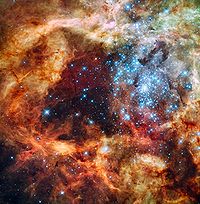- R136
-
R136 The massive, young stellar grouping, called R136, is only a few million years old and resides in the 30 Doradus Nebula, a turbulent star-birth region in the Large Magellanic Cloud (LMC), a satellite galaxy of our Milky Way. There is no known star-forming region in our galaxy as large or as prolific as 30 Doradus. The image, taken in ultraviolet, visible, and red light by Hubble's Wide Field Camera 3, spans about 100 light-years.
Credit: Hubble Space TelescopeObservation data (J2000.0 epoch) Constellation Dorado Right ascension 05h 38m 42.396s Declination -69° 06′ 03.36″ Distance 157 kly (48.5 kpc) Apparent magnitude (V) 9.50 Physical characteristics Other designations [1] UCAC2 1803442, SAO 249329, HD 38268, TYC 9163-1014-1, CD-69 324, GC 7114 See also: Open cluster, List of open clusters R136, formally known as RMC 136, is a super star cluster[2] near the center of the 30 Doradus complex (also known as the Tarantula Nebula), in the Large Magellanic Cloud. It is a young star cluster, 1-2 million years old,[2] of giant and supergiant stars. The majority of its stars are of spectral type O3,[2] with 39 confirmed O3-type stars.[2][3] Additionally, there are several confirmed Wolf-Rayet stars.[3][4]
The cluster R136 contains several components.[1] The nature of the central component, R136a, was initially unclear. R136a was once thought to be a hypergiant star of about 1500 solar masses, 30 million times as bright as the sun, with a surface temperature of 55-60,000 K and about 50 million miles in diameter. R136a's true nature was resolved by holographic speckle interferometry and found to be a dense star cluster[5] containing, among other things, twelve very massive and luminous stars in its core.[6] These stars had initial masses calculated to be in the range of 37 to 76 solar masses.[6] Three extremely luminous stars (R136a1, R136a2 and R136a3) dominate the cluster and are separated by only 0.10 and 0.48 arcsec. One of the stars, R136a1, is the most massive star found to date with 265 solar masses,[7] as well as the most luminous at 8,700,000 times the brightness of the Sun.[8] R136 produces most of the energy that makes the Tarantula Nebula visible. The estimated mass of the cluster is 450,000 solar masses, suggesting it will probably become a globular cluster in the future.[9]
Components
NAME Right ascension Declination Apparent magnitude (V) Spectral type Database references R136a 05h 38m 43.3s −69° 06′ 08″ star cluster SIMBAD R136a1 (BAT99 108) 05h 38m 42.43s −69° 06′ 02.2″ 12.77 WN SIMBAD R136a2 (BAT99 109) 05h 38m 42.45s −69° 06′ 02.2″ 13.38 Wolf–Rayet SIMBAD R136a3 (BAT99 106) 05h 38m 42.291s −69° 06′ 03.45″ 12.93 WN SIMBAD R136 Ab (SNR B0538-69.2) 05h 37m 51.6s −69° 10′ 23″ 9.59 SNR SIMBAD R136 Ac (PSR J0537-6910) 05h 37m 47.6s −69° 10′ 20″ pulsar SIMBAD R136b (BAT99 111) 05h 38m 42.78s −69° 06′ 03.1″ 13.66 O4 SIMBAD R136c (BAT99 112) 05h 38m 42.896s −69° 06′ 04.92″ 12.86 WN SIMBAD Gallery
See also
References
- ^ a b Simbad data for RMC 136
- ^ a b c d Massey, P ; Hunter, D. (January 1998). "Star Formation in R136: A Cluster of O3 Stars Revealed by Hubble Space Telescope Spectroscopy". The Astrophysical Journal 493 (1): 180. Bibcode 1998ApJ...493..180M. doi:10.1086/305126
- ^ a b Lebouteiller, V.; Bernard-Salas, J.; Brandl, B.; Whelan, D. G.; Wu, Yanling; Charmandaris, V.; Devost, D.; Houck, J. R. (June 2008). "Chemical Composition and Mixing in Giant H II Regions: NGC 3603, 30 Doradus, and N66". The Astrophysical Journal 680 (1): 398–419. Bibcode 2008ApJ...680..398L. doi:10.1086/587503
- ^ Melnick, J. (December 1985,). "The 30 Doradus nebula. I - Spectral classification of 69 stars in the central cluster". Astronomy and Astrophysics 153 (1): 235–244. Bibcode 1985A&A...153..235M.
- ^ Weigelt, G.; Baier, G. (September 1985). "R136a in the 30 Doradus nebula resolved by holographic speckle interferometry". Astronomy and Astrophysics 150: L18–L20. Bibcode 1985A&A...150L..18W.
- ^ a b Koter, Heap, and Hubeny, Alex; Heap, Sara R.; Hubeny, Ivan (1998). "An Empirical Isochrone of Very Massive Stars in R136A". The Astrophysical Journal 509 (2): 879–896. Bibcode 1998ApJ...509..879D. doi:10.1086/306503. http://www.iop.org/EJ/abstract/0004-637X/509/2/879/.
- ^ Amos, Jonathan (21 July 2010). "Astronomers detect 'monster star'". BBC News. http://www.bbc.co.uk/news/science-environment-10707416. Retrieved 21 July 2010.
- ^ Chow, Denise (21 July 2010). "Heftiest Star Discovery Shatters Cosmic Record". SPACE.com. http://www.space.com/scienceastronomy/eso-massive-stars-discovered-100721.html. Retrieved 21 July 2010.
- ^ Bosch, Guillermo; Terlevich, Elena; Terlevich, Roberto (2009). "Gemini/GMOS Search for Massive Binaries in the Ionizing Cluster of 30 Dor". Astronomical Journal 137 (2): 3437–3441. Bibcode 2009AJ....137.3437B. doi:10.1088/0004-6256/137/2/3437.
Further reading
- ESA Hubble, Symphony of colours in the Tarantula, 15 December 2004
- Crowther, P.A.; L.J. Smith (1997). "Fundamental parameters of Wolf-Rayet stars / VI. Large Magellanic Cloud WNL stars". Astronomy and Astrophysics (Gower Street, London, WC1E 6BT, UK: Department of Physics and Astronomy, University College London) 320: 500–524. Bibcode 1997A&A...320..500C.
- R 136 in the Aladin previewer
External links
Categories:- Unclassified star clusters
- Dorado constellation
- Large Magellanic Cloud
- Tarantula Nebula
- Henry Draper Catalogue objects
Wikimedia Foundation. 2010.


